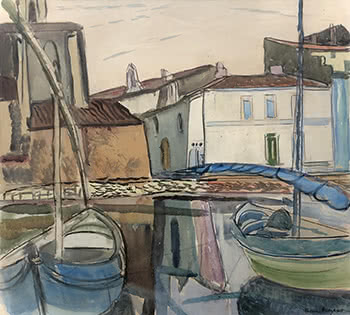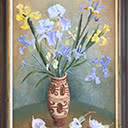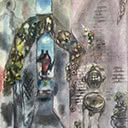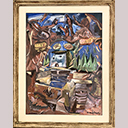Venetian Lagoon
41 x 47 cm
est. $50,000 - 75,000
PROVENANCE
Collection of Helen Stewart, artist Purchased from 47th Annual
Exhibition, Academy of Fine Arts Wellington, 1928
Collection of Mrs Louise Ryan,
Helen Stewart's niece. Inherited from the
Estate of Helen Stewart, 1983
Held in the family of Mrs Louise Ryan
since her death in 2012
EXHIBITED
47th Annual Exhibition,
Auckland Society of Arts, Auckland 1928
47th Annual Exhibition,
Academy of Fine Arts, Wellington, 1928
48th Annual Exhibition,
Auckland Society of Arts, 1929
REFERENCE
Frances Hodgkins database number
FH0679 completefranceshodgkins.com
If Hodgkins' watercolour of Caudebec-en-Caux demonstrated her skilled handling of the medium and celebrated a type of impressionist approach to landscape, the 1920s saw a marked change of approach. The fishing villages on the French Riviera played a major part in Hodgkins' ongoing development as a modernist. After staying briefly in St Tropez at the beginning of December 1920, Hodgkins moved west to Cassis before settling for some time in Martigues. Since the 19th century, these villages have been a favoured location for artists, Martigues particularly favoured by Andr Derain, Raoul Dufy, Camille Corot, and Matthew Smith. Even today Martigues remains a resolute little fishing village, charming when bathed in the warm Mediterranean sun but also prone to being swept by the fierce dusty winds that make their way across north Africa before depositing their grit on its local streets, while surprisingly crisp in winter, when Hodgkins chose to work there. The port sits at the mouth of a huge lagoon known as l' tang de Berre, which makes its way to the sea by way of the Caronte canal. In the port itself, today the original five narrow islets are linked by bridges, making it easy to walk the tiny distance from one strip of land to another. In a letter written to Rachel Hodgkins when Frances first arrived, she noted; Martigues is called the Venice of France. . . A rather grandiloquent name for a very dirty little fishing village, on one of the indefatigable mouths of the Rhone, a few miles to the westward of Marseilles - it's as filthy as it's picturesque. . . We thought this a more suitable place for pupils & cheaper & less out of the way and a good half way stage before we push further South towards Spain. . . The food is wonderfully good - floors are cold - light poor, but the dear sun which makes up for all… https:// completefranceshodgkins.com/objects/29522/ letter-from-frances-hodgkins-to-rachel-hodgkins Her more experimental watercolours, however, were all created en plein air, in which she developed a new approach to working with colour, spurred by the cheerful simplicity of her setting. Colour resonates in Martigues, not least in the smaller islets, but the most popular location to set up an easel is Le Miroir aux Oiseaux, or Mirror of Birds. A small L-shaped inlet leading off the mouth of one of the canals, artists are attracted to its sheltered location and the effects of the sparkling water when the sun shines. Wrapped around Le Miroir is the Quai Brescon, lined by fisherman's cottages painted in various hues, either on the whole fa ade or gaily outlining windows, doors, and shutters. These colours are reflected in the fishermen's boats, riding at anchor. While Hodgkins' simplified forms suggest aspects of the Cubist movement in Paris, she was reminded of the simple architecture which had captured her imagination in Morocco in 1901-02, and the way in which their forms are accentuated by the strong Mediterranean light. In Venetian Lagoon, she has rapidly blocked in the patterns of earthenware tiles on roofs, while simplifying the arches of L'Eglise Sainte- Madeleine-de-l' le (the Church of St Madeleine of the Island) which can be made out on the left in the background, and the curving forms of the fishing boats drawn up beside the Quai, their brightly painted hulls echoing the myriad colours of windows and doors in the background. Furled sails on the boat on the right provide animation, while an angled wooden mast divides up the structure of the church. But there is another innovation here, which was to become a leitmotif of her Martigues paintings in the five visits made to the village from 1921 - 31. Unlike most fishing ports, which have a constant flow of boats entering and departing port, Le Miroir gets its name from its glassy surface, undisturbed for much of the day once boats have set out to work. What Hodgkins now sought to capture was the effect of reflections on her compositions, as illustrated in the central section of Venetian Lagoon. At each visit throughout the 1920s, she continued to explore the opportunities provided by their shimmering effects, and the contrast they provided with their bustling surroundings.
MARY KISLER





